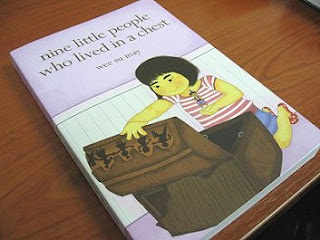How many weeks later? I'm not sharing.
As a result, I may have been... effusive in my praise of the book. But after rolling around in what passes for journalism these days, what a gust of fresh air!
Something to keep firmly in mind.
Times of turmoil
A deft touch conveys stories of upheaval without resorting to unrealistic extremesfirst published in The Star, 03 June 2011
Isn't today's media action-packed? Blood and guts, bullets and bombs, skin and sex, and reality TV shows where f-bombs drop like names at a socialites' ball. And it seems as though whole sections in bookstores both real and virtual have been taken over by genres that combines elements of all the above and then some.
I wonder if it is perhaps in reaction to this trend that publishers Marshall Cavendish have re-released something cleaner and calmer.
Born in 1951 in Rangoon, Burma (now Yangon, Myanmar), to parents of Chinese descent, Minfong Ho was raised in Thailand and graduated from America's prestigious Cornell University with a bachelor's degree in economics. She became a journalist, and then taught English at Thailand's Chiang Mai University. She currently resides in New York with her family.
During her first years at Cornell, she turned to writing to fight her homesickness. Her short story, Sing To The Dawn, won a prize and was later expanded into a novel published in 1975. She would go on to write more novels and story collections. Rice Without Rain (1986) was based on her experiences with Thailand's turbulent politics in the 1970s, and her times as an aid volunteer helping Cambodian refugees during the Vietnamese invasion of Cambodia inspired The Clay Marble (1991).
Marshall Cavendish has compiled these three works into a single volume, The Minfong Ho Collection. All three novels feature young Thai or Cambodian village lasses whose daily struggles are compounded by bigger forces intruding upon their little worlds.
In Sing To The Dawn, we are introduced to Dawan, a brilliant, headstrong student who wins a scholarship and a chance to study in a big-city school.
However, she faces objections from her parents and the apathy and fatalism of her fellow villagers, all of whom seem to view the idea of a girl getting educated as something radical. Her so-called blessing also drives a wedge between her and her brother.
Seventeen-year-old Jinda gets caught up in Thailand's student-led democracy movement in the 1970s in Rice Without Rain.
A group of university students arrive at her village, bringing with them the promise of change. Brought to the city, ostensibly to speak out against greedy landlords, Jinda soon learns that she is but a pawn in a bigger struggle, and that the price of change may be too high to pay.
The Clay Marble's 12-year-old Dara has lived through two "liberation" campaigns: one led by the Khmer Rouge against the Cambodian royals, and the other by Vietnamese forces fighting the previous regime. When the Khmer Rouge's reign crumbles, she and her family join the refugees fleeing towards the Thai-Cambodia border. Along the way, Dara meets a fellow refugee with a knack for making toys out of clay. But the peace she finds in a refugee camp along the border is eventually shattered when the war finally catches up.
What's refreshing about these three works is how unremarkable they look at first glance. Ho doesn't dramatise the human tragedies with graphic depictions of wartime atrocities – something that seems to be de rigueur nowadays in print, on TV and online.
Unlike the reports filed by some of those "celebrity" journalists on 24-hour "news channels", the subjects take centre stage, not the writer. Ho's use of simple, unadorned language does not detract from the respect and sensitivity she shows her characters and their world, and the gravity of the issues the young heroines face.
Gender and class discrimination, corruption, superstition versus modernity, and the callousness of the powers-that-be in their bid to maintain the status quo become all the more poignant when one sees that little has changed in these countries since these works were first published in the 1970s and 1980s.
In this collection, Ho does not shed excessive blood, rip bodices or curse like a flotilla of pirates to tell her tales. She doesn't have to. The deft touch of her pen, tempered by first-hand experience, brings to life the voices and the pain of these three village girls, and that alone is enough. Though meant for children and young adults, readers of all ages will find this honest, easy read almost like journalism at its finest.
The Minfong Ho Collection
Minfong HoMarshall Cavendish Editions
399 pages
Fiction
ISBN: 978-981-4302-45-6
Categories:
Book Reviews,
The Star
















